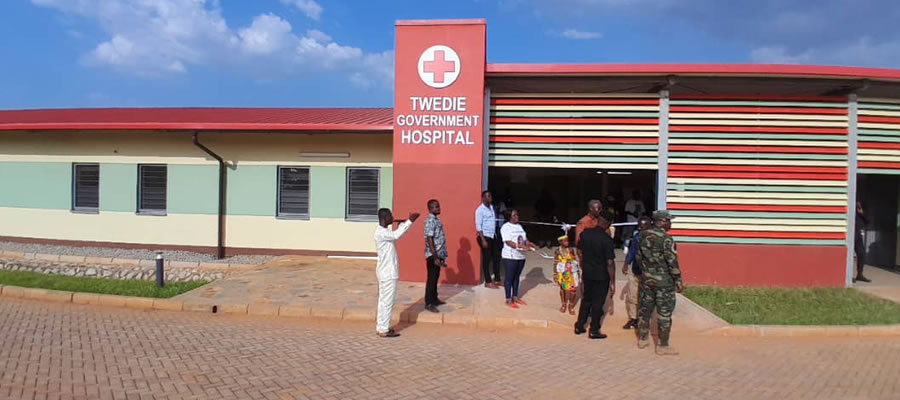

This chapter describes the demographic characteristics of the District, including population size and distribution, by sex and type of locality (urban-rural). This is followed by the age-sex structure detailing age distributions across the District by sex. The final section of the chapter discusses migration, fertility and mortality characteristics of the District.
Population Size and Distribution
Table 2.1 shows that Atwima Kwanwoma District recorded a total population of 90,634 during the 2010 population and Housing Census (PHC) with 48.3 percent males and 51.7 percent females. The population residing in rural localities (80.2%) is more than those in the urban localities (19.7%). The age-dependency ratio for the District is 80.8, signifying relatively high dependence on the working population. The rural population has a higher dependency ratio 82.6 than the urban population, 73.6. The sex ratio in the district is 93.5. This means that for every 100 females, there are about 94 males, indicating that there are more females than males.
Age-Sex Structure
The age-sex structure of the District is graphically represented by a population pyramid. The broad base of the pyramid in Figure 2.1 indicates a youthful structure with more children and youth. The shape narrows from age 34 to 60 and shrinks significantly from age 64 towards age 85 which gives it the conical shape. Females dominate in the District except for age groups (0-4 and 5-9) where the males are more than the females.
Fertility, Mortality and Migration
Fertility
Fertility refers to the actual birth performance that is, frequency of childbearing among a given female population. During the 2010 PHC, 23,148 women (15-49 years) were enumerated in the Atwima Kwanwoma District (Table 2.2). Out of the total, about 2 percent gave birth within the 12 months before the census night. The Total Fertility Rate (TFR) is the average number of children that would be born to a woman by the time she ended childbearing if she were to pass through all her childbearing years conforming to the age specific fertility rates of a given year. The TFR for the District stands at 3.43 which is a little higher than the Regional figure of 3.26 The number of live births per 1,000 women within the last 12 months to the census night for the District is 104.2 whiles the Crude Birth Rate stands at 26.6. Crude Birth Rate (CBR) is the number of births in a given year divided by the number of people in the population in the middle of that year.
Note: * Number of live births per 1,000 women aged 15-49 years
** Number of live births per 1,000 population
Mortality
Table 2.3 shows females 12 years and older totaling 31,926 and the number of children ever born and those still surviving. The data indicates that children ever born and children surviving are 79,875 (2.5%) and 70,008 (1.8%) respectively. For all the age categories, males (40,358) dominate the females (39,517) for children ever born. However in comparing children surviving with the children ever born, the females survive more than the males.
Again, the table shows that children ever born to those aged 12-14 is significantly low (12), though the proportion of surviving children is 1.6 percent. As age increases from 15 to 60 years and older, the percentage of children ever born increases up to age 35 to 39 years and started decreasing again but however reached its peak at age 60 years and older with the highest record. On the other hand, percentage of surviving children is almost constant between age 15 and 40 but decreases from 45 to 60 years and older.
Table 2.4 shows the deaths that occurred in Atwima Kwanwoma District and the Region at large, 12 months preceding the census night. The data indicates that out of the total population in the Region (4,780,380), about 27,948 persons died within the 12 months preceding the census night. The District also recorded 493 deaths with deaths due to accident, violence, homicide and suicide being 15.4 percent. About 84.6 percent of the population died as a result of other causes such as natural deaths and sicknesses in the District. The crude death rate for the District however, recorded 5.4 deaths per 1,000 populations.
Age specific death rates by sex
Figure 2.2 shows the death rate by sex in Atwima Kwanwoma District. Among every 1000 persons in the district, about 13 males and 8 females lose their lives before age 5. The death rates for both males and females rise more or less equally until ages 50 – 59 and upwards where death rate for males rises steadily. Comparatively, age 55 and upwards recorded more deaths for both males and females than age group 5 to 49. Deaths among females between ages 45 to 49 and 55 to 59 rise sharply probably signifying maternal mortality. Both under age 5 and 70+ males recorded higher deaths compared to females. The lowest death rate for both males and females occur among the age group 10 – 19 while the highest death rate occur at age 70+.
Migration
Table 2.5 shows that there are 39,951 migrants out of which 26,075 were born elsewhere in the region. Most of the migrants who were born in other regions are from Central Region (2,457), Upper East (2,290) and Brong Ahafo (2,280). Only 514 migrants were born outside Ghana. Most of the inter-regional migrants have stayed in the district for a period between one to four years. Only a small proportion (less than 10 percent) has stayed for 20 years and more
Date Created : 11/23/2017 6:14:45 AM












 facebook
facebook
 twitter
twitter
 Youtube
Youtube
 +233 593 831 280
+233 593 831 280 0800 430 430
0800 430 430 GPS: GE-231-4383
GPS: GE-231-4383 info@ghanadistricts.com
info@ghanadistricts.com Box GP1044, Accra, Ghana
Box GP1044, Accra, Ghana